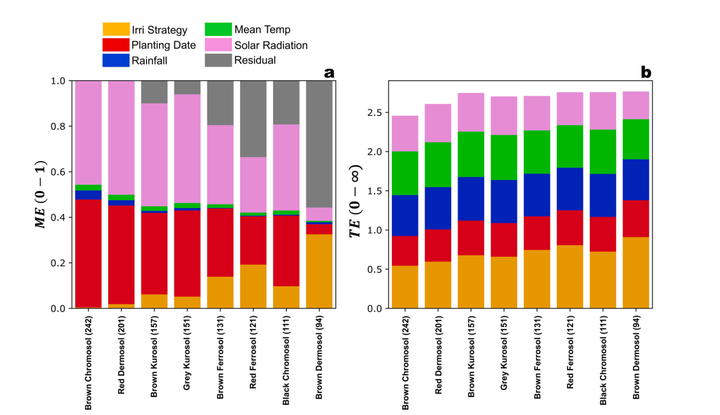[20] Impact of crop management and environment on the spatio-temporal variance of potato yield at regional scale

Abstract
The uncertainties associated with crop model inputs can affect the spatio-temporal variance of simulated yields, particularly under suboptimal irrigation. The aim of this study was to determine and quantify the main drivers of irrigated potato yield variance; as influenced by crop management practices as well as climate and soil factors. Using a locally calibrated crop model (APSIM), three planting dates × three irrigation strategies (plus a non-water limited treatment) were simulated using 30 years of historical weather data across potato production areas in Tasmania, Australia. We used (i) correlation analysis, (ii) variance decomposition and (iii) maps to visualise the spatial decomposition of variance of potato yield. Our results showed that the implementation of potential irrigation compensated for the impact of planting date on climate drivers of simulated yield and changed the most important yield driving factors from irrigation and planting date to global solar radiation (r = 0.69−0.81). Under early-planting, we found positive correlations of simulated yield vs. global solar radiation (r up to 0.75 under high and medium irrigation) and between the simulated yield and rainfall (r up to 0.55 under low irrigation). In general, a mix of negative and positive correlations were found for minimum and maximum temperature depending on soil type. Using variance decomposition analysis, we found that crop management factors explained the greatest yield variance depending on soil type related to plant available water capacity (PAWC). For soils with high PAWC (>200 mm), most variance was explained by global solar radiation (56–62 %) followed by planting date (43–47 %). However, when PAWC values decreased from 242 mm to 94 mm, the contribution of global solar radiation and planting date were reduced from 62 % to 5.8 % and from 47 % to 4.4 %, respectively, and the contribution of irrigation strategy increased from 0.4%–32.5%. We identified a need to quantify and differentiate the variance contribution of environmental and crop management factors on crop yield and within these factors, discriminate the key drivers of yield variance at regional scale.